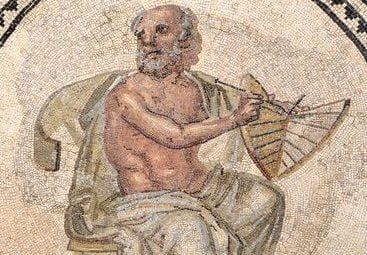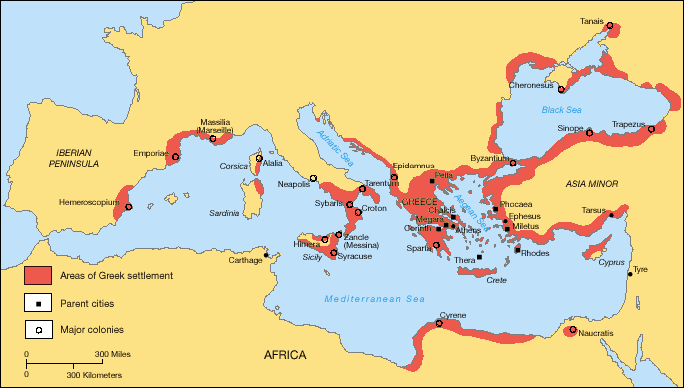
The Milesian School was a branch of pre-Socratic philosophy founded in the sixth century BC in the Asia Minor town of Miletus. It produced three thinkers who were the pioneers of philosophy in ancient Greece, and they formed the foundation of the later Western scientific method.
It is generally considered to be the first school of thought of all Ancient Greek, and thus Western, philosophy. Later philosophers built on their groundbreaking ideas and added to them, but it was these men who were first known for using reason, rather than superstition, to understand the world around them.
The school consisted of three philosophers: Thales, Anaximander, and Anaximenes, who were all primarily interested in cosmology, and the origin and substance of the world. They all believed the world was made of a fundamental element called an arche. They all attributed the arche of the world to, respectively, water, apeiron (the unlimited), and air governed by nous (mind or intelligence).
From world of superstition and myth to rational thought
These pre-Socratic thinkers arose from a world dominated by mythology and superstition and, nearly by themselves, formed the beginnings of the scientific method as we know it today.
The pre-Socratic era lasted for about two centuries, during which the expanding Persian Achaemenid Empire was stretching to the west, while the Greeks were advancing in trade and sea routes, reaching Cyprus and Syria.
The knowledge that we do have of the pre-Socratics derives from the accounts of later writers such as Plato, Aristotle, Plutarch, Diogenes Laërtius, Stobaeus, and Simplicius, and some early Christian theologians, notably Clement of Alexandria and Hippolytus of Rome.
The term “pre-Socratic” was coined to highlight a fundamental change in philosophical inquiries between the philosophers who lived before Socrates, who were interested in the structure of nature and cosmos, and Socrates and his successors, who were mostly interested in ethics and politics.
The most important feature of pre-Socratic philosophy was the use of reason to explain the universe. The pre-Socratic philosophers shared the intuition that there was a single explanation that could explain both the plurality and the singularity of the whole – and that explanation would not be direct actions of the gods.
They rejected traditional mythological explanations of the phenomena they saw in the world around them in favor of more rational explanations, boldly initiating analytic and critical thought. Their efforts were directed at the investigation of the ultimate basis and essential nature of the world and the universe.
They sought the material principle, or arche, behind all things, and the method of its origin and disappearance. The pre-Socratics saw the world as a cosmos, an ordered arrangement that could be understood via rational inquiry.
The creation of the concepts of analogy, rhythm, symmetry, and deduction
In their effort to make sense of the cosmos, they coined new terms and concepts such as rhythm, symmetry, analogy, deductionism, reductionism, and others.
Although the pre-Socratics were not atheists, they minimized the extent of the gods’ involvement in natural phenomena — such as thunder — or totally eliminated the gods from the operations of the natural world.
Pre-Socratic philosophy encompasses the first of the three phases of ancient Greek philosophy, which spanned approximately one thousand years. The first pre-Socratics, comprising the Milesians, as well as Xenophanes and Heraclitus, rejected traditional cosmogony and attempted to explain nature based on empirical observations and interpretations.
Later thinkers associated with pre-Socratic thought, the Eleatics, resisted the idea that there could be any metamorphosis of material things. Based on their ideas, called radical monism, they believed that only one substance exists, and that is what forms the Kosmos.
The post-Eleatics (mainly Empedocles, Anaxagoras, and Democritus) opposed most Eleatic teaching and returned to the naturalism of the Milesians, however.
The pre-Socratics were succeeded by the second phase of ancient philosophy, including Platonism, Cynicism, Aristotelianism, Epicureanism, Academic skepticism, and Stoicism, which were prominent until the year 100 BC. In the third phase of Ancient Greek philosophy, thinkers studied the brilliant foundations already laid down by their predecessors.
In 1903, the German professors H. Diels and W. Kranz published “Die Fragmente der Vorsokratiker” (The Fragments of the pre-Socratics), which collected all of the known fragments of the works of these earliest Greek thinkers. Scholars now use this book to reference the fragments using a coding scheme called Diels–Kranz numbering.
Collectively, these fragments are called the doxography (derived from the latin doxographus; derived from the Greek word for “opinion” doxa).
Thales of Miletus
Thales of Miletus, who lived from c. 624 to 546 BC, is considered to be the father of philosophy — although tragically, none of his writings have survived. He is considered the first western philosopher since he was the first to use reason, to use proof, and to generalize.
He himself coined the word cosmos, the first Western word to describe the universe. He contributed to geometry and even predicted the eclipse which occurred in 585 BC.
Most importantly, Thales posed the fundamental philosophical question about the origin and the substance of the world, while providing answers based on empirical evidence and reasoning.
Anaximander
Fellow School of Miletus member Anaximander, who lived from 610 to 546 BC, was another brilliant polymath from the time of Ancient Greece. He wrote, in a fragment of his work “On Nature” that is referred to only by its Dielz-Kranz number, DK 12 B 1, he states:
“That from which all things are born
the beginning of all things
the first foundation of things is the Unlimited (apeiron);
The source from which coming-to-be is, for things that are, and for
their passing away in accordance with necessity.
For they give justice and pay retribution to each other for their mutual
injustice according to the ordered process of time.”
Anaximander was born into a wealthy family; he was also a statesman in addition to being a brilliant theoretician. He showed interest in many fields, including mathematics and geography as well. He drew the first map of the world, was the first to conclude that the earth is spherical, and made instruments to mark time, much like a clock.
He postulated as the first principle an undefined, unlimited substance without qualities (apeiron), out of which the primary opposites, including hot and cold, moist and dry, became differentiated.
Anaximander’s conception of a universe that is governed by laws shaped the philosophical thinking of centuries to come; historians believe it was as important as the discovery of fire or Einstein’s breakthroughs in science.
Anaximenes
This third member of the Milesian School, who lived from 585 to 525 BC, was a younger contemporary and friend of Anaximander, and the two worked together on various intellectual projects. He also wrote a book on nature in prose. Anaximenes took for his basic principle aēr (air), conceiving it as being modified, via thickening and thinning, into the other classical elements: fire, wind, clouds, water, and earth.
While his theory resembled that of Anaximander’s, as they both claimed a single source of the universe, Anaximenes suggested sophisticated mechanisms in which air is transformed to other elements, mainly because of changes of density. He was considered the father of naturalistic explanations.
Xenophanes was born in Colophon, an Ionian town near Miletus. He was a well-traveled poet whose primary interests, however, were theology and epistemology. He believed that we have no way of knowing whether there was one god or many gods, or if there was a hierarchy among multiple deities.
To critique the anthropomorphic representation of the gods by his contemporary Greeks, he pointed out that different peoples depicted their gods as looking like themselves. He famously said that if oxen, horses, or lions could draw, they would draw their gods as oxen, horses, or lions.
This critique was not limited to the looks of gods but their behavior as well. Greek mythology, especially as shaped by the poets Homer and Hesiod, attributed moral failures such as jealously and adultery to the gods. Xenophanes opposed this practice, holding that gods must by their very natures be morally superior to humans.
The Milesian school is not synonymous with the Ionian, which includes the philosophies of the Milesians plus distinctly different Ionian thinkers such as Heraclitus. The Ionian School contains the three philosophers that form the Milesian School as well as a few more who were added during the 5th century.
However, the Ionian School looked more into the thought behind everything while the Milesian School was more focused on nature itself.
Other philosophical giants who followed the Milesian School
Heraclitus, who lived from 535 – c. 475 BC, was another pre-Socratic, Ionian philosopher who was a native of the city of Ephesus, also in Asia Minor.
His paradoxical philosophy and appreciation for wordplay and cryptic utterances earned him the epithet “The Obscure” inantiquity. He wrote one single work, only fragments of which have survived.
The hallmark of Heraclitus’ philosophy is the concept that everything in the universe is in flux. In fragment DK B30, he writes: “This world-order (Kosmos), the same of all, no god nor man did create, but it ever was and is and will be: everliving fire, kindling in measures and being quenched in measures.”
Like previous monist philosophers, Heraclitus claimed that the arche of the world was indeed fire, which was subject to change; this made him a materialist monist.
A fundamental idea for Heraclitus was logos, an ancient Greek word with a variety of meanings; he might have used a different meaning of the word with each mention of the concept in his book. Logos appeared to mean a universal law that unites the cosmos, according to one fragment of his, work which says: “Listening not to me but to the logos, it is wise to agree (homologein) that all things are one” (DK 22 B50).
While logos is everywhere, very few ordinary people are familiar with such a lofty concept, according to Heraclitus. Fragment B 19 reads: (the hoi polloi) “…do not know how to listen (to Logos) or how to speak (the truth)” This thinker’s thought on logos influenced the Stoics, who referred to him to support their belief that rational law governs the universe.

Heraclitus’ ideas on the nature of change were embodied in the phrases “No man ever steps in the same river twice”, and “panta rhei” (“everything flows”). This aspect of his philosophy is contrasted with that of the later philosopher Parmenides, who believed in “being” and in the static nature of the universe.
Both Heraclitus and Parmenides, the founder of the Eleatics, which was a later pre-Socratic school, had an influence on Plato, who went on to influence all of Western philosophy.
The Eleatic school (consisting of Parmenides, Zeno of Elea, and Melissus) followed in the philosophical tracks of the first members of the Milesian School in the 5th century BC.
Parmenides’ philosophy has been explained with the slogan “whatever is is, and what is not cannot be”. This is generally considered one of the first digressions into the philosophical concept of being, and has been contrasted with Heraclitus’ statement that “No man ever steps into the same river twice” as one of the first digressions into the philosophical concept of becoming.
Scholars generally believed that either Parmenides was responding to Heraclitus, or Heraclitus to Parmenides.
Incredibly, only beginning in the classical period do we have complete surviving texts of the great thinkers — whereas in the pre-Socratic era we have only fragments of their works.
It is nothing short of miraculous that the momentous ideas created by the earliest philosophical and scientific thinkers of the Milesian School survives at all today, and that their achievements serve as the basis of all the scientific and rational thought which forms the basis of our scientific understanding of the world today.
See all the latest news from Greece and the world at Greekreporter.com. Contact our newsroom to report an update or send your story, photos and videos. Follow GR on Google News and subscribe here to our daily email!



